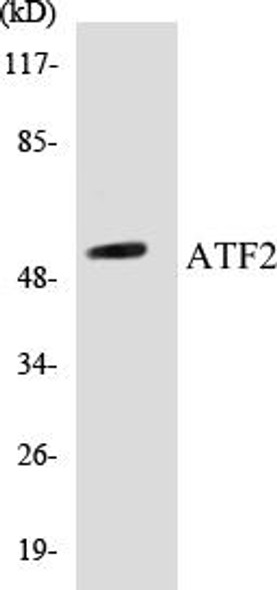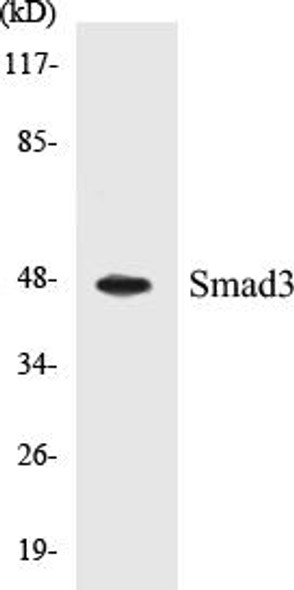Epigenetics and Nuclear Signaling
PIAS3 Colorimetric Cell-Based ELISA Kit
- SKU:
- CBCAB00813
- Product Type:
- ELISA Kit
- ELISA Type:
- Cell Based
- Research Area:
- Epigenetics and Nuclear Signaling
- Reactivity:
- Human
- Reactivity:
- Mouse
- Reactivity:
- Rat
- Detection Method:
- Colorimetric
Description
| Product Name: | PIAS3 Colorimetric Cell-Based ELISA |
| Product Code: | CBCAB00813 |
| ELISA Type: | Cell-Based |
| Target: | PIAS3 |
| Reactivity: | Human, Mouse, Rat |
| Dynamic Range: | > 5000 Cells |
| Detection Method: | Colorimetric 450 nmStorage/Stability:4°C/6 Months |
| Format: | 96-Well Microplate |
The PIAS3 Colorimetric Cell-Based ELISA Kit is a convenient, lysate-free, high throughput and sensitive assay kit that can detect PIAS3 protein expression profile in cells. The kit can be used for measuring the relative amounts of PIAS3 in cultured cells as well as screening for the effects that various treatments, inhibitors (ie siRNA or chemicals), or activators have on PIAS3.
Qualitative determination of PIAS3 concentration is achieved by an indirect ELISA format. In essence, PIAS3 is captured by PIAS3-specific primary antibodies while the HRP-conjugated secondary antibodies bind the Fc region of the primary antibody. Through this binding, the HRP enzyme conjugated to the secondary antibody can catalyze a colorimetric reaction upon substrate addition. Due to the qualitative nature of the Cell-Based ELISA, multiple normalization methods are needed:
| 1. | A monoclonal antibody specific for human GAPDH is included to serve as an internal positive control in normalizing the target absorbance values. |
| 2. | Following the colorimetric measurement of HRP activity via substrate addition, the Crystal Violet whole-cell staining method may be used to determine cell density. After staining, the results can be analysed by normalizing the absorbance values to cell amounts, by which the plating difference can be adjusted. |
| Database Information: | Gene ID: 10401, UniProt ID: Q9Y6X2, OMIM: 605987, Unigene: Hs.435761 |
| Gene Symbol: | PIAS3 |
| Sub Type: | None |
| UniProt Protein Function: | PIAS3: Functions as an E3-type small ubiquitin-like modifier (SUMO) ligase, stabilizing the interaction between UBE2I and the substrate, and as a SUMO-tethering factor. Plays a crucial role as a transcriptional coregulation in various cellular pathways, including the STAT pathway and the steroid hormone signaling pathway. Involved in regulating STAT3 signaling via inhibiting STAT3 DNA-binding and suppressing cell growth. Monomer. Binds SUMO1 and UBE2I. Interacts with BCL11A, HMGA2, IRF1, MITF and NCOA2. Interacts with STAT5; the interaction occurs on stimulation by PRL. Interacts with GFI1; the interaction relieves the inhibitory effect of PIAS3 on STAT3- mediated transcriptional activity. Interacts with AR, PLAG1 and ZFHX3. Interacts with STAT3; the interaction occurs on stimulation by IL6, CNTF or OSM and inhibits the DNA binding activity of STAT3. By dihydrotestosterone (DHT) in prostate cancer cells. Isoform 1 is expressed in most tissues except thymus and small intestine. Isoform 3 is expressed only in brain, heart, thymus, muscle, lung, testis, lactating breast and embryonic stem cells. Belongs to the PIAS family. |
| UniProt Protein Details: | Protein type:EC 6.3.2.-; SUMO conjugating system; Nuclear receptor co-regulator Chromosomal Location of Human Ortholog: 1q21 Cellular Component: cytoplasm; dendrite; synapse; nucleus Molecular Function:protein C-terminus binding; protein binding; potassium channel regulator activity; enzyme binding; zinc ion binding; protein N-terminus binding; SUMO ligase activity; ligase activity Biological Process: positive regulation of protein sumoylation; protein sumoylation; transcription, DNA-dependent; regulation of transcription, DNA-dependent; response to hormone stimulus; positive regulation of membrane potential |
| NCBI Summary: | This gene encodes a member of the PIAS [protein inhibitor of activated STAT (signal transducer and activator of transcription)] family of transcriptional modulators. The protein functions as a SUMO (small ubiquitin-like modifier)-E3 ligase which catalyzes the covalent attachment of a SUMO protein to specific target substrates. It directly binds to several transcription factors and either blocks or enhances their activity. Alternatively spliced transcript variants of this gene have been identified, but the full-length nature of some of these variants has not been determined. [provided by RefSeq, Jul 2008] |
| UniProt Code: | Q9Y6X2 |
| NCBI GenInfo Identifier: | 56405390 |
| NCBI Gene ID: | 10401 |
| NCBI Accession: | Q9Y6X2.2 |
| UniProt Secondary Accession: | Q9Y6X2,Q9UFI3, |
| UniProt Related Accession: | Q9Y6X2 |
| Molecular Weight: | 628 |
| NCBI Full Name: | E3 SUMO-protein ligase PIAS3 |
| NCBI Synonym Full Names: | protein inhibitor of activated STAT, 3 |
| NCBI Official Symbol: | PIAS3 |
| NCBI Official Synonym Symbols: | ZMIZ5 |
| NCBI Protein Information: | E3 SUMO-protein ligase PIAS3; zinc finger, MIZ-type containing 5; protein inhibitor of activated STAT protein 3 |
| UniProt Protein Name: | E3 SUMO-protein ligase PIAS3 |
| UniProt Synonym Protein Names: | Protein inhibitor of activated STAT protein 3 |
| Protein Family: | E3 SUMO-protein ligase |
| UniProt Gene Name: | PIAS3 |
| UniProt Entry Name: | PIAS3_HUMAN |
| Component | Quantity |
| 96-Well Cell Culture Clear-Bottom Microplate | 2 plates |
| 10X TBS | 24 mL |
| Quenching Buffer | 24 mL |
| Blocking Buffer | 50 mL |
| 15X Wash Buffer | 50 mL |
| Primary Antibody Diluent | 12 mL |
| 100x Anti-Phospho Target Antibody | 60 µL |
| 100x Anti-Target Antibody | 60 µL |
| Anti-GAPDH Antibody | 60 µL |
| HRP-Conjugated Anti-Rabbit IgG Antibody | 12 mL |
| HRP-Conjugated Anti-Mouse IgG Antibody | 12 mL |
| SDS Solution | 12 mL |
| Stop Solution | 24 mL |
| Ready-to-Use Substrate | 12 mL |
| Crystal Violet Solution | 12 mL |
| Adhesive Plate Seals | 2 seals |
The following materials and/or equipment are NOT provided in this kit but are necessary to successfully conduct the experiment:
- Microplate reader able to measure absorbance at 450 nm and/or 595 nm for Crystal Violet Cell Staining (Optional)
- Micropipettes with capability of measuring volumes ranging from 1 µL to 1 ml
- 37% formaldehyde (Sigma Cat# F-8775) or formaldehyde from other sources
- Squirt bottle, manifold dispenser, multichannel pipette reservoir or automated microplate washer
- Graph paper or computer software capable of generating or displaying logarithmic functions
- Absorbent papers or vacuum aspirator
- Test tubes or microfuge tubes capable of storing ≥1 ml
- Poly-L-Lysine (Sigma Cat# P4832 for suspension cells)
- Orbital shaker (optional)
- Deionized or sterile water
*Note: Protocols are specific to each batch/lot. For the correct instructions please follow the protocol included in your kit.
| Step | Procedure |
| 1. | Seed 200 µL of 20,000 adherent cells in culture medium in each well of a 96-well plate. The plates included in the kit are sterile and treated for cell culture. For suspension cells and loosely attached cells, coat the plates with 100 µL of 10 µg/ml Poly-L-Lysine (not included) to each well of a 96-well plate for 30 minutes at 37°C prior to adding cells. |
| 2. | Incubate the cells for overnight at 37°C, 5% CO2. |
| 3. | Treat the cells as desired. |
| 4. | Remove the cell culture medium and rinse with 200 µL of 1x TBS, twice. |
| 5. | Fix the cells by incubating with 100 µL of Fixing Solution for 20 minutes at room temperature. The 4% formaldehyde is used for adherent cells and 8% formaldehyde is used for suspension cells and loosely attached cells. |
| 6. | Remove the Fixing Solution and wash the plate 3 times with 200 µL 1x Wash Buffer for five minutes each time with gentle shaking on the orbital shaker. The plate can be stored at 4°C for a week. |
| 7. | Add 100 µL of Quenching Buffer and incubate for 20 minutes at room temperature. |
| 8. | Wash the plate 3 times with 1x Wash Buffer for 5 minutes each time. |
| 9. | Add 200 µL of Blocking Buffer and incubate for 1 hour at room temperature. |
| 10. | Wash 3 times with 200 µL of 1x Wash Buffer for 5 minutes each time. |
| 11. | Add 50 µL of 1x primary antibodies (Anti-PIAS3 Antibody and/or Anti-GAPDH Antibody) to the corresponding wells, cover with Parafilm and incubate for 16 hours (overnight) at 4°C. If the target expression is known to be high, incubate for 2 hours at room temperature. |
| 12. | Wash 3 times with 200 µL of 1x Wash Buffer for 5 minutes each time. |
| 13. | Add 50 µL of 1x secondary antibodies (HRP-Conjugated AntiRabbit IgG Antibody or HRP-Conjugated Anti-Mouse IgG Antibody) to corresponding wells and incubate for 1.5 hours at room temperature. |
| 14. | Wash 3 times with 200 µL of 1x Wash Buffer for 5 minutes each time. |
| 15. | Add 50 µL of Ready-to-Use Substrate to each well and incubate for 30 minutes at room temperature in the dark. |
| 16. | Add 50 µL of Stop Solution to each well and read OD at 450 nm immediately using the microplate reader. |
(Additional Crystal Violet staining may be performed if desired – details of this may be found in the kit technical manual.)






